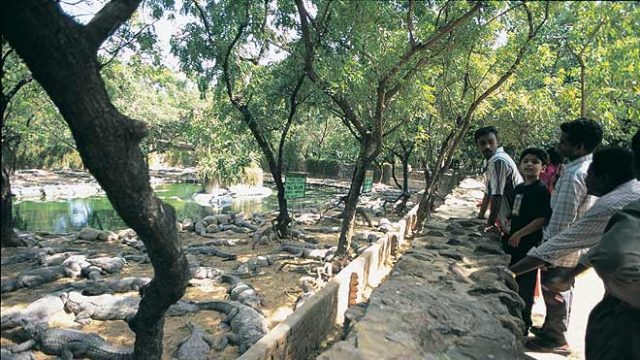For obvious reasons, I’m humming “Never smile at a crocodile” as I walk into Crocodile Bank. But I see no welcome grin to take me in; Sunday afternoons seem as sacred to crocodiles as to humans. Siesta time. And that disappoints the other visitors, especially the scores of kids who are waiting breathlessly to see Croc Bank’s largest inhabitant, Jaws-3, a 16-footer who’s chosen this time to relax underwater. Other parents are trying to dissuade adventurous offspring from buying ‘feeding tickets’, which allow them to feed the crocs. And there’s a fair crowd at the snake venom extraction centre, where an Irula, a traditional snake-catcher, milks kraits, Russell’s vipers and cobras for their venom.

As I wander through the park, I can’t help but overhear snatches of conversation. “No, no. They are very dangerous animals,” says one overwrought father to his kids, explaining why he’s not going to buy them a feeding ticket. Elsewhere, a software type is egging on his friend to throw a stone into the gharial pit. “Don’t be scared, da. They won’t eat you. They are all asleep.” Someone else is earnestly saying that he’ll definitely come back between February and April “to see the egg laying”. There are also several kids from the nearby village schools, acting as unofficial guides, cleaning up, and even assisting at the gift shop.
Thanks to the numerous educational programmes Croc Bank conducts, these children know plenty about crocodiles and treat the park as their own. There are also summer camps where city kids learn useful facts: that crocs sleep with their mouths open to keep cool, that they can live for over 100 years, that they can eat just once a fortnight and preserve food in their stomach for a week or more. They can tell between a crocodile, alligator and a gharial, and between a mugger and a caiman.

Crocodile Bank is obviously more than just another zoo. Set up in 1976 by American herpetologist Romulus Whitaker in response to the indiscriminate killing of crocodiles, Crocodile Bank is a breeding and research station that’s home to 14 of the 23 crocodile species in the world, as well as monitor lizards and turtles—most of them bred in captivity. It started off with 25 crocodiles, including the three Indian species—the mugger, the saltwater crocodile and the gharial. Today, there are close to 2,500 crocodiles, alligators and gharials here, and the breeding programme is on hold due to lack of space. (The breeding centre does, however, still breed crocodiles on request for zoos in and outside the country.)

Breeding and research are two of the most important functions of the park, apart from public education. Crocodile Bank has a large research station in the Andamans, and has started a 10-year project in north India, which includes a captive breeding programme and the setting up of gene pools. The park also has a small fund used to aid short-term research projects done by students of wildlife management and ecology. It also conducts critical research into the habits of crocodiles. In fact, its director, Harry Andrews, is one of the scientists who conducted long-term research into the effect of temperature on the sex of crocodiles. (Essentially, the male gene survives only at a very specific temperature. Hotter or colder, and you’ll have to change the blue bows to pink.)
Apart from protecting the crocodilian species, Crocodile Bank is also home to the Irula Snake Catchers’ Industrial Cooperative Society. The Irula tribe used to depend on catching and killing venomous snakes for their livelihood, but when the government banned such killing, they set up this society with Whitaker’s aid. Today, the Irulas still track snakes, but catch them and milk them for venom and release them into the wild again. The venom is sold to labs that make antidotes to treat snakebites.
Most people stop by at Crocodile Bank on their way to Mahabalipuram; in fact, Andrews says one of the many reasons for choosing the site was its proximity to places of tourist interest. Sadly, the lure of fun parks and amusement arcades along the smooth-as-silk East Coast Road has seen a 40 per cent fall in the number of visitors, though gate collections are still sufficient to pay for the upkeep of the park. The regulars know that feeding is on Wednesdays and Saturdays and scorn what they call “tourist feeding”, so the crowds are dense on those days. Croc Bank has also started a Night Safari on weekends, a guided tour of the park after dark. Perhaps the guides will start by singing: “Don’t be rude, never mock. Throw a kiss, not a rock. Clear the aisle and always smile at Mister Crocodile.”




